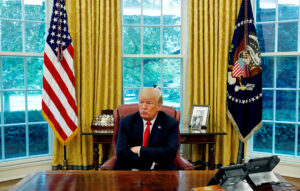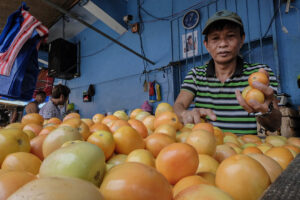As the world awaits how US President-elect Donald Trump will weaponize trade, it is useful to understand how the US and China have wielded trade sanctions in the past to achieve their foreign and domestic policy goals.
The US has often used trade sanctions to deal with issues such as nuclear proliferation, human rights abuses, or geopolitical aggression, and now under Trump, to reduce trade deficit and bring back jobs to the US. The US, for example, has imposed sanctions on Iran to curb its nuclear program and on Russia following its annexation of Crimea. During Trump’s first presidency, he imposed tariffs on $250 billion worth of Chinese goods, targeting sectors like technology, steel, and consumer goods. These measures were designed not only to pressure Beijing on what the US claimed as intellectual property theft, human rights violations, and unfair trade practices but also to incentivize US companies to shift production to the US.
Similarly, China has also wielded trade sanctions as an instrument of foreign policy. Since 2010, China has imposed sanctions against 15 countries including Australia, Japan, South Korea, Norway, the Philippines, Mongolia, Canada, Lithuania, and the United States. These sanctions vary in motivation, scope, target, and duration, but their strategies tend to be ambiguous and informal but also proportional, conditional, and ultimately pragmatic. If President Trump has the art of the deal, China has the art of the trade war.
Historically, China tended to wield trade sanctions over what it claims as infringements of its core interests — territorial integrity, political stability, economic priorities, and national security. In 2012, for example, Beijing imposed trade sanctions — that lasted four years — on the Philippines after it filed a case against China over the Scarborough Shoal in the South China Sea. When Norway awarded the 2010 Nobel Peace Prize to Chinese dissident Liu Xiaobo, China blocked Norwegian salmon exports for six years. In 2016, China imposed sanctions on Mongolia after the Dalai Lama’s visit, targeting Mongolian mining exports with administrative delays. South Korea experienced a similar response when it deployed the THAAD missile defense system in 2016. China retaliated by restricting tourism, banning Korean cultural products, and increasing inspections on South Korean goods — a move that cost the South Korean economy an estimated $7.5 billion over six years. In 2020, after Australia called for an independent investigation into the origins of COVID-19 and banned Huawei from its 5G rollout, China imposed broad sanctions on Australian coal, barley, beef, and wine estimated at over $20 billion worth of exports.
In all of these cases, trade sanctions were eventually eased as a result of policy shifts or changes in political leadership in sanctioned countries. These examples illustrate the range and conditional nature of China’s trade sanctions. Economic pressure is applied strategically, and sanctions are often lifted when target countries adjust policies, offer diplomatic concessions, or prioritize economic cooperation with Beijing.
While China’s motivations are predictable — to protect its core interests — its sanctions strategy is often ambiguous and informal. Unlike Western powers, which publicly announce and justify sanctions — even with Trump’s trade deficit reduction project — China often attributes trade disruptions to technical or regulatory issues.
When Mongolia hosted the Dalai Lama in 2016, Chinese authorities cited vague “technical delays” to restrict Mongolian mining exports. Similarly, restrictions on Australian and Philippines agricultural goods were framed as regulatory inspections rather than retaliatory measures.
Moreover, China often employs informal tools such as administrative delays, increased inspections, and unofficial pressures on businesses. In its 2021 dispute with Lithuania over the establishment of a Taiwanese representative office, China suspended trade flows without formal announcements and pressured multinational firms to sever ties with Lithuanian suppliers. This strategy — highly effective but difficult to contest through legal channels — highlights China’s ability to leverage its vast market informally.
Notably, China’s trade sanctions also tend to be tit for tat but proportional, calibrated to maintain pressure while avoiding full-scale economic disruption. For example, during Trump’s first presidency, the 2018 trade war with China showcased a proportional use of tariffs to address perceived trade imbalances. Tariffs were imposed on $250 billion worth of Chinese imports, targeting sectors such as technology, steel, and consumer goods, while China retaliated with tariffs on $110 billion worth of US goods, focusing on agriculture and automobiles, politically sensitive goods in the US.
While China’s sanctions strategy tends to be ambiguous, informal, proportional, and conditional, it is ultimately pragmatic. For instance, China has maintained robust trade relations with countries despite ongoing territorial disputes. Bilateral trade with India, for instance, reached $135 billion in 2022 despite continued tensions along the border which have since been settled this year. Trade with the US remains robust despite trade rivalry. Similarly, China remains Vietnam’s largest trading partner, even as both countries vie for contested claims in the South China Sea. The same with the Philippines although China has already warned it is running out of patience. Trade with Taiwan further underscores this dynamic. Despite Beijing’s political stance that Taiwan is a breakaway province, economic ties remain significant. In 2022, Taiwan’s exports to China accounted for 40% of its total exports, dominated by semiconductors vital to China’s technology ambitions. These cases point to the complexities of China’s trade relationships and China’s pragmatic balancing act between strategic competition and economic interdependence.
The economic impact of China’s sanctions often depends on the targeted country’s reliance on Chinese markets. Smaller economies, or those with concentrated export dependencies, are more vulnerable. South Korea’s deployment of the THAAD missile defense system in 2016 led to restrictions on tourism, entertainment, and consumer goods, costing South Korea an estimated $7.5 billion over six years. However, countries capable of diversifying their trade relationships can mitigate the effects. Australia’s experience with China illustrates this point. After facing sweeping trade restrictions, Australia redirected coal exports to India and barley to the Middle East, demonstrating that sanctions can sometimes accelerate trade diversification rather than achieving their intended outcome.
China’s trade sanctions must be seen within its broader foreign policy strategy, which balances punitive measures with economic incentives. Alongside sanctions, China uses tools such as favorable trade agreements, foreign direct investment (FDI), and development aid to strengthen ties with friendly states and win over rivals. The Belt and Road Initiative (BRI) exemplifies Beijing’s efforts to expand geopolitical influence through economic engagement. China’s vast outbound tourism sector has also emerged as a lever of economic diplomacy, rewarding or penalizing countries based on bilateral ties.
While China’s sanctions strategy offers flexibility, it also raises concerns about international trade norms. The World Trade Organization (WTO) provides mechanisms for resolving formal trade disputes, but China’s informal measures often fall outside its regulatory framework. Japan’s 2012 WTO victory against China’s rare earth export restrictions highlighted these limitations. Although China complied with the ruling, the case underscored the challenges of addressing politically motivated trade disruptions through existing global mechanisms. This is not to say that China has completely abandoned the WTO. In fact, it recently filed in the WTO several cases against the US and EU over the imposition of tariffs on Chinese electric vehicles.
In short, China’s art of the trade war seems to be a combination of discretion, informality, ambiguity, proportional escalation, conditionality, pragmatism, and reliance on global institutions as it suits its purpose. This strategy allows Beijing to exert economic pressure, provide flexibility while avoiding overt escalation. Its effectiveness will depend on the economic resilience of targeted countries, their ability to diversify trade relationships, and the broader geopolitical context. While sanctions impose costs, they also carry risks for China, including disruptions to its own supply chains and the potential for countries to deepen ties with alternative partners.
On my next op-ed, I will speculate on the possible economic impacts if China imposes sweeping trade sanctions on the Philippines and when it might do so.
Eduardo Araral is an associate professor at the Lee Kuan Yew School of Public Policy, National University of Singapore. This op-ed is written in his personal capacity.















